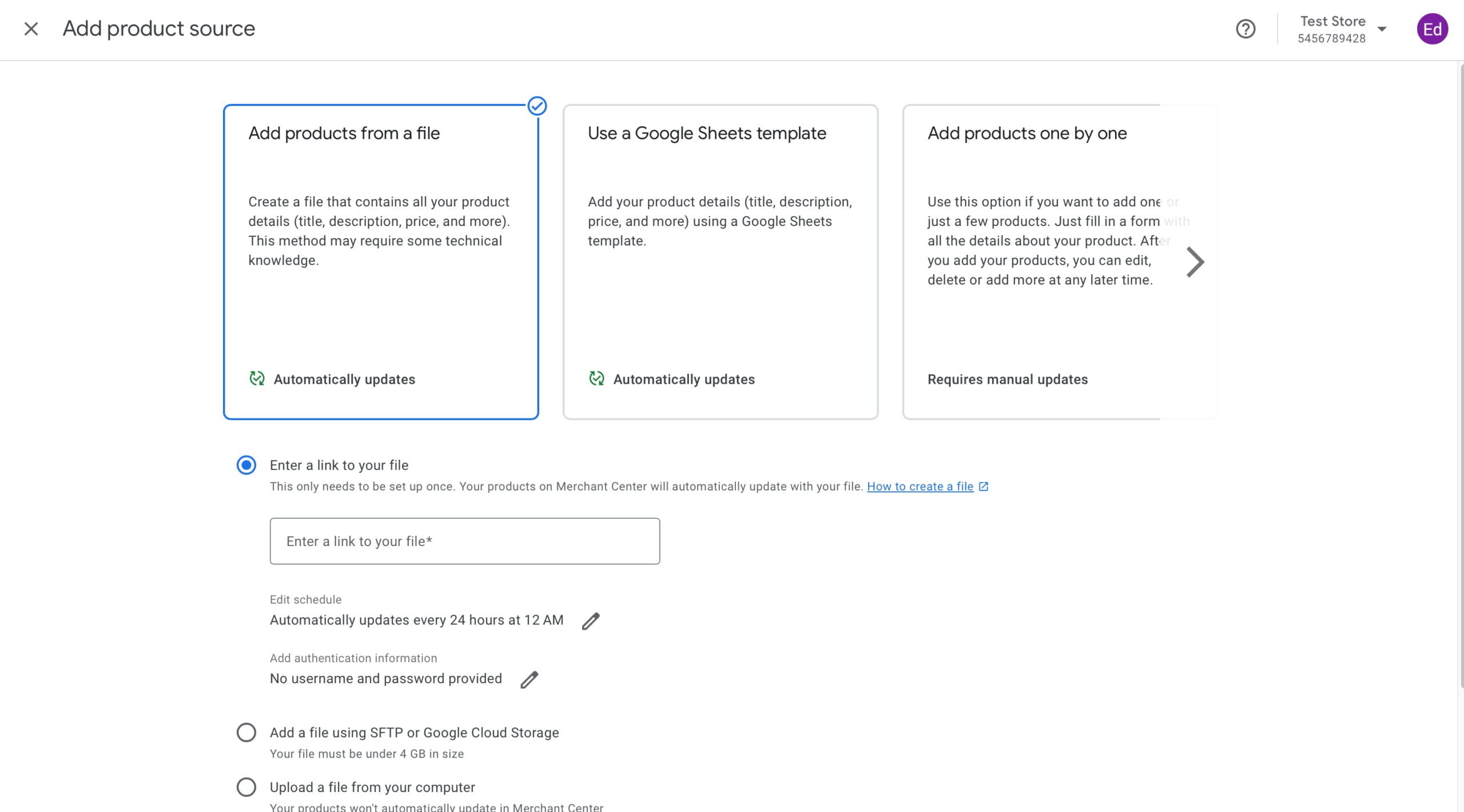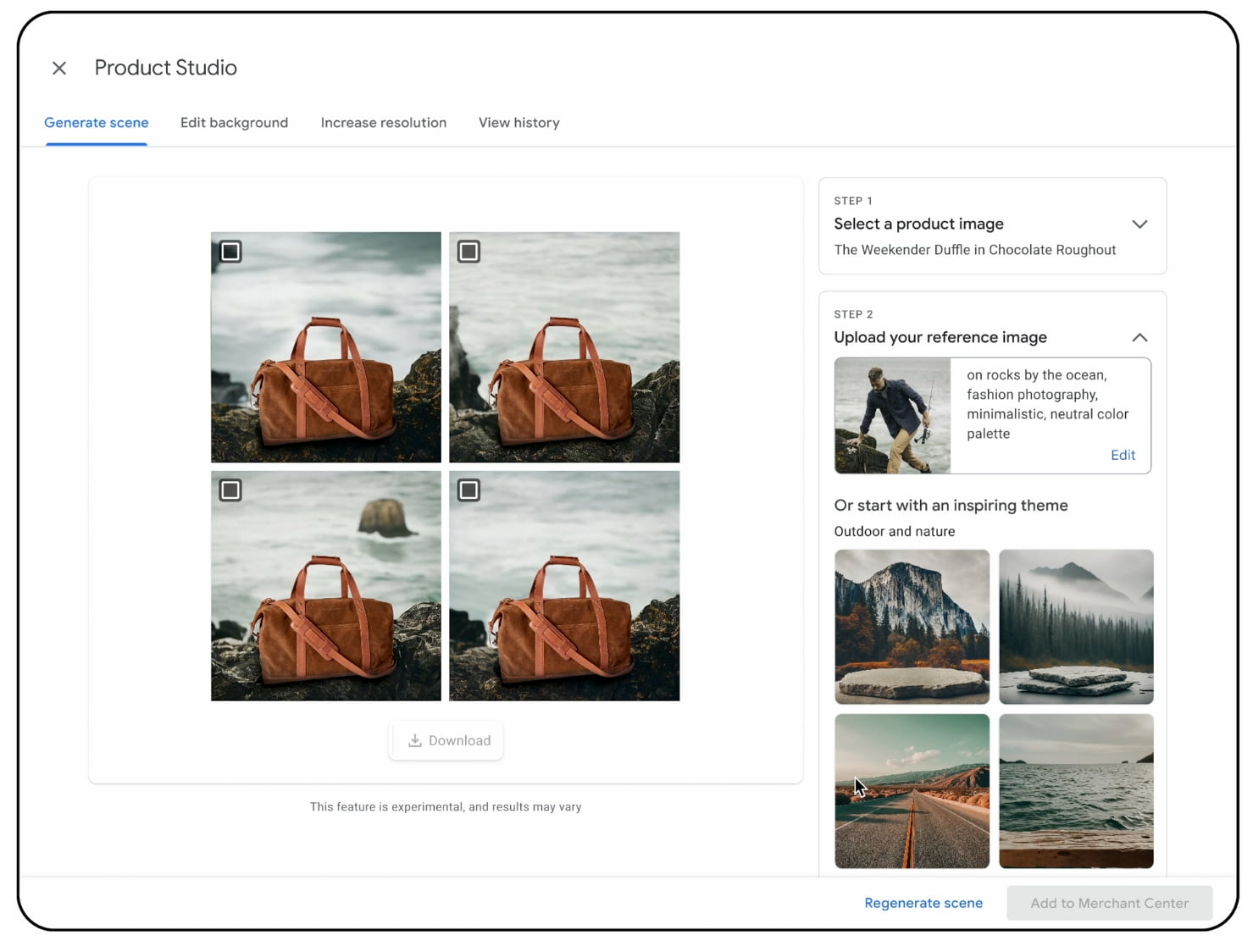E-commerce companies are always looking for ways to improve their online presence to boost sales. The Google Merchant Center (GMC) is an important tool for this as it helps companies showcase their products across the Google ecosystem. This guide is intended to provide retailers with an understanding of GMC. It provides useful insights to optimize product listings and improve visibility on Google Shopping.
What is Google Merchant Center?
Google Merchant Center (GMC) is a free-to-use platform for e-commerce companies that want to take advantage of Google’s wide reach. It is a central hub where retailers can upload and manage product data. This allows business owners to make their products visible across various services such as Search, Maps, YouTube and Google Shopping. Merchant Center is an important piece of the eCommerce SEO puzzle.
The Google Merchant Center homepage
Google Merchant Center Next is now online
With the recent upgrade to Merchant Center Nextthe platform offers a more optimized and intuitive experience. Now it’s much easier to manage products and improve their performance.
After registering and logging in, retailers get access to features like Product Studioan AI-powered tool for creating product images and videos. This tool generates customized product assets, improves image quality and removes backgrounds. Additionally, the unified product listing enables omnichannel retailers to seamlessly manage online and local inventory.
The new Analytics tab provides comprehensive insights into market trends and pricing strategies. For example, the Prices tab in Merchant Center Analytics provides retailers with valuable insight into how their product prices compare to what customers see on Google.
This tool allows retailers to evaluate their pricing strategies by seeing whether their products are more expensive, cheaper, or comparable to competitors’ offerings. The tab provides a breakdown by different brands and products, identifying those with significant price differences. In addition, it also offers offer price suggestions that are intended to increase your competitiveness.
Merchant Center Next also has a much better design with intuitive navigation and easy website verification options. Finally, retailers have an easy-to-understand interface to manage their product information and optimize their presence on Google. The platform’s advanced analytics tools provide greater visibility into business performance.
The benefits of using Merchant Center
Google Merchant Center offers significant benefits for eCommerce businesses focused on revenue growth. It increases visibility by allowing products to appear in Google Shopping results and ads, reaching millions of potential customers. This wider audience increases the chances of conversion.
The platform improves the shopping experience by providing detailed product listings with high-quality images and descriptions. This helps customers make quick, informed decisions and increases conversion rates.
GMC also provides data-driven insights through its analytics tools. These tools help companies optimize product listings by analyzing metrics such as prices, clicks, and conversions to improve their e-commerce strategy.
Additionally, GMC supports both free and paid listings. Free listings increase the visibility of smaller businesses at no additional cost, while paid ads more specifically target specific customer segments.
The integration into the Google ecosystem is seamless. It connects to Google Analytics and Google Ads, providing a comprehensive overview of marketing efforts and improving ROI measurement.
Finally, GMC offers companies flexibility and control over product presentation and placement. This ensures that marketing efforts align with business goals. An AI-powered tool like Product Studio also helps create robust product data to increase efficiency.
Setting up Google Merchant Center
You need to set up a GMC account to use the Google network to improve your eCommerce business. Here is a step-by-step guide to help you through the process:
- Sign up for Merchant Center:
Visit the Google Merchant Center website and click “Join for Free” to begin registration.
- Provide business information:
Enter your company name, address and contact details. This information is used for the various features and tools in GMC. Indicate your business model, whether you sell products online, in a physical store, or both. This flexibility allows GMC to tailor its features to your business needs.
- Verify and claim your website:
Follow the instructions for your chosen method to complete the verification process. You can use an HTML file upload, an HTML tag, Google Analytics, Google Tag Manager, a code via a work email address, or an eCommerce platform (like Shopify, WooCommerce, or Wix).
- Configure shipping and tax settings:
Set up shipping options and tax information. These settings are important because they affect how your products appear in listings and ads. Highlight special offers like free shipping to attract more customers. Comply with Google’s shipping and tax information requirements to avoid rejections.
- Add product information:
Once your account is set up, add your product information. This includes creating a product feed, which we will discuss later.
Integration with third-party platforms
Manually managing product data can be time-consuming and error-prone. You can automate this process by integrating Google Merchant Center with third-party eCommerce platforms. By using this process, your product listings will always be updated and accurate.
Connecting your e-commerce platform is very easy. In your Merchant Center account, navigate to the Settings menu and select Data Sources and Add Product Source to link it. Follow the on-screen instructions to connect your platform (e.g. Shopify). This typically involves authorizing the connection and selecting the data you want to sync.

After the integration, you can manage your products directly in the Merchant Center. Make any necessary updates or changes to ensure your listings remain competitive and compliant with Google’s guidelines.
Benefits of integrating your eCommerce platform
There are many benefits to integrating your e-commerce platform with Google Merchant Center. For one thing, you get automatic updates. Therefore, product information, including images, prices and descriptions, are automatically synced from your e-commerce platform to GMC. This eliminates the need for manual data entry and reduces the risk of inconsistencies.
The integration also results in streamlined management as you can manage product data directly from your e-commerce platform. This frees up time and resources to focus on other aspects of your business. It should also result in fewer errors in your product data. Automatic syncing minimizes human error so product information displayed on Google is always accurate and up-to-date.
Merchant Center product data feeds
Product data feeds (or data sources as they are now called) are the backbone of your Google Merchant Center account. These serve as the primary source of information that Google uses to display your products on its platforms. You should optimize these feeds to accurately represent your products and reach the right audience.
What is a product data feed/data source?
A product data feed or data source is a structured file containing detailed information about your products. This file contains attributes such as product titles, descriptions, prices and images. Google uses this data to create Shopping ads and listings. It is therefore crucial that this data is accurate and complete.
Methods for adding products
Google Merchant Center offers multiple methods for uploading product data, providing flexibility to meet the unique needs of your business.
Automatic addition from your online shop
Google can automatically add products from your online store using structured data markup (schema.org) on your product pages. This method ensures that all changes made to your website, such as: B. price updates or product availability, are reflected in the Merchant Center. Simply provide your store URL and implement structured data markers on all product pages to enable automatic updates.
Connection to e-commerce platforms
We have already mentioned this option. Connect platforms like Shopify and WooCommerce to Google Merchant Center to automatically sync product data. This integration ensures product information is continually updated without manual intervention, reducing errors and saving time.
File uploads
Upload product data using a file (e.g. TSV, TXT, XML). This versatile method allows you to combine data from multiple sources into a single file. Make sure you use proper formatting to avoid errors. You can also host the file at a URL to sync daily with Merchant Center.
Google Sheets template
You can also use a Google Sheets template to manage product data. All changes made in the table are automatically synchronized with the Merchant Center. This provides a user-friendly interface for data management, with automatic updates ensuring consistency.
Manual product entry
You can manually enter product details individually in Google Merchant Center. This is ideal for small inventories or specific product updates. It allows you to easily add, edit or delete products as needed.
Content API for Shopping
The Content API for Shopping is a powerful tool that allows developers to programmatically manage their Google Merchant Center accounts. It offers a more dynamic and efficient way to manage large or complex product inventories. This interface allows you to automate updates and maintain accurate product data across all Google platforms.
The elements of a product data feed
Optimizing your product data source requires attention to several key elements:
- Product title: To improve search visibility, use clear, descriptive titles with relevant keywords. Avoid promotional copy or excessive punctuation.
- Product descriptions: Provide detailed and accurate descriptions, highlighting unique features and specifications. Add relevant keywords naturally.
- Pictures: Use high quality images with a simple background. Make sure the images are clear, professional and accurately represent the product.
- Prices: Keep prices current and competitive. Maintain consistency between the price on your website and in the data feed.
- Availability: Update product availability regularly to reflect current inventory. Use attributes such as “in stock,” “out of stock,” or “available for pre-order.”
- Clear product identification: Add GTINs, MPNs, and brand information to help Google accurately categorize and display your products.
Maintaining your Merchant Center account
Regularly reviewing your GMC account is important to identify opportunities and troubleshoot problems. It has various account monitoring tools, such as the overview page. This page provides an overview of your account performance. It highlights key metrics such as product status and performance trends. Use this page to identify items that require attention and to assess the impact of recent changes.
You can use the Google Merchant Center product tool to identify errors and issues in your product data feed. Periodically review the Attention Required section for warnings and errors. Find missing attributes or policy violations so you can fix them to avoid product rejections.
The new version of Merchant Center contains a significantly improved analysis area. Detailed performance reports analyzing prices, clicks, impressions and conversion rates can be found here. Use these insights to understand customer behavior and make informed decisions to optimize your product listings and campaigns.
Common problems and how to fix them
Troubleshooting issues in your Google Merchant Center account is critical to keeping products visible and compliant. The most common issues include data errors, policy violations, rejections, and performance issues.
If there are data errors, update your product feed to match Google’s specifications and correct any missing attributes or price differences. Follow Google’s Shopping Guidelines to avoid account suspension.
Review rejected products to identify and resolve problems, then request re-inspection. Optimize product titles, descriptions, and images to increase relevance. Adjust bids and targeting in Google Ads to improve visibility and reach.
Strategies to improve performance
Implement effective strategies to increase the performance of your Google Merchant Center. Update your product data feed with accurate pricing and availability. Enhance product listings with detailed descriptions and high-quality images, and consider adding reviews to build trust.
Use Merchant Promotions to highlight special offers and leverage Google Ads audience targeting to reach specific customer segments. Test and optimize campaigns with different ad formats and bidding strategies to refine your approach. You can maintain your growth and maximize your eCommerce success by actively managing your GMC account.
To maximize the potential of Google Merchant Center, leverage advanced features like Local Inventory Ads to improve product visibility and attract local shoppers. Try Product Studio for AI-powered content creation and streamline the production of high-quality product assets.
Improve customer experience by providing clear return policies and ensuring secure data collection. Integrate tools like Google Analytics and Google Ads to get comprehensive insights and targeted marketing strategies.

All about Google Merchant Center
Google Merchant Center is an essential tool for eCommerce businesses looking to increase their online visibility and sales. By following this guide, SEO experts can unlock GMC’s full potential, drive growth, and achieve eCommerce success. Log in to your GMC account today, start optimizing, and watch your business thrive.


